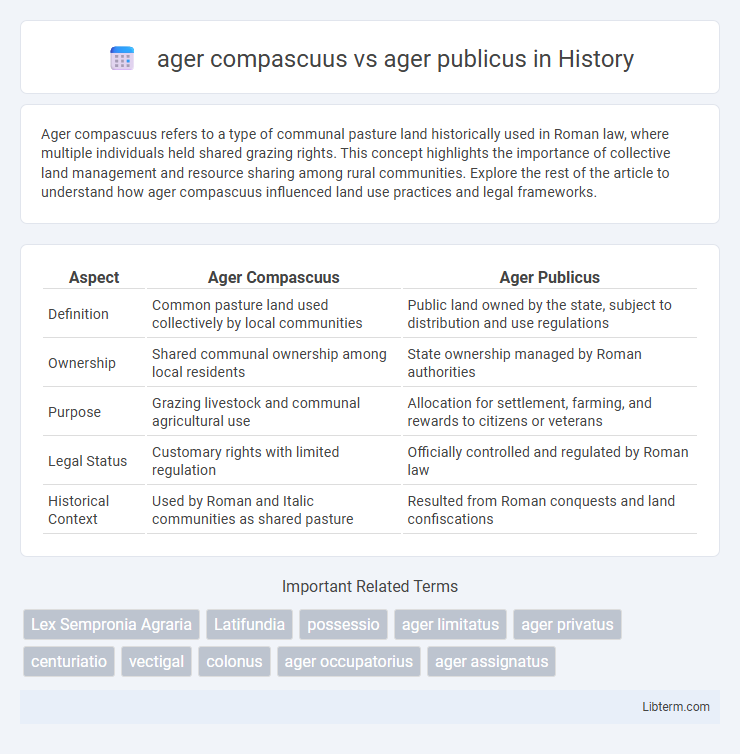Ager compascuus refers to a type of communal pasture land historically used in Roman law, where multiple individuals held shared grazing rights. This concept highlights the importance of collective land management and resource sharing among rural communities. Explore the rest of the article to understand how ager compascuus influenced land use practices and legal frameworks.
Table of Comparison
| Aspect | Ager Compascuus | Ager Publicus |
|---|---|---|
| Definition | Common pasture land used collectively by local communities | Public land owned by the state, subject to distribution and use regulations |
| Ownership | Shared communal ownership among local residents | State ownership managed by Roman authorities |
| Purpose | Grazing livestock and communal agricultural use | Allocation for settlement, farming, and rewards to citizens or veterans |
| Legal Status | Customary rights with limited regulation | Officially controlled and regulated by Roman law |
| Historical Context | Used by Roman and Italic communities as shared pasture | Resulted from Roman conquests and land confiscations |
Introduction to Ager Compascuus and Ager Publicus
Ager compascuus refers to shared pasture lands in ancient Roman law where multiple landowners had grazing rights, promoting communal agricultural use without private ownership. In contrast, ager publicus denotes state-owned public land acquired through conquest or confiscation, which the Roman government controlled and could lease or distribute to citizens. The distinction between ager compascuus and ager publicus highlights different legal frameworks for land use and ownership in Roman agricultural and property systems.
Historical Background of Roman Land Division
Ager compascuus referred to shared pasture lands in ancient Rome allocated mainly for communal grazing, distinct from ager publicus, which denoted state-owned public lands often confiscated from conquered territories. The historical background of Roman land division highlights ager publicus as a vital resource for Roman expansion and wealth distribution, while ager compascuus played a crucial role in local agricultural economies by regulating common land use. These land categories illustrate the complexity of Roman agrarian policies and social structures during the Republic and early Empire periods.
Definition of Ager Compascuus
Ager compascuus refers to common pasture land in ancient Roman law, where multiple individuals had shared grazing rights without exclusive ownership. Unlike ager publicus, which denoted public land owned by the state or community and subject to state control, ager compascuus emphasized joint use primarily for livestock grazing. Its legal framework allowed equitable access among neighboring landowners, promoting communal agricultural practices.
Definition of Ager Publicus
Ager publicus refers to land owned collectively by the Roman state, often acquired through conquest or confiscation, and allocated for public use or leased to individuals. Unlike ager compascuus, which specifically designated shared grazing land used communally by farmers, ager publicus encompassed a broader range of state-owned properties including agricultural fields, pastures, and urban areas. The management and distribution of ager publicus played a crucial role in Roman economic and social policies, influencing land reforms and citizenship rights.
Legal Framework and Ownership Rights
Ager compascuus refers to common pasture land traditionally used collectively by local communities, governed by customary law that restricts individual ownership and emphasizes shared usage rights. In contrast, ager publicus denotes state-owned land managed under Roman public law, granting the state exclusive ownership while permitting limited lease or usage rights to private individuals. Legal frameworks for ager compascuus prioritize communal stewardship and collective access, whereas ager publicus establishes clear government ownership with controlled allocation to private parties.
Economic Significance of Both Land Types
Ager compascuus, a common graze land primarily used for shared livestock grazing, enhanced pastoral economies by providing essential resources without requiring individual ownership, thus supporting local agrarian communities' sustainability. In contrast, ager publicus, publicly owned land often seized from conquered territories, held significant economic importance by facilitating state control over agricultural production and enabling lease revenues that funded public expenditures. Both land types played crucial roles in ancient Roman economic structures by balancing communal benefits with state resource management strategies.
Social Impact on Roman Society
Ager compascuus, shared pasture land, facilitated cooperative grazing among Roman farmers, promoting communal resource management and reducing conflicts in rural communities. In contrast, ager publicus, state-owned land often leased to wealthy elites or used for public projects, exacerbated social inequalities by concentrating land control and limiting access for small farmers. This disparity between communal and state land use significantly influenced class tensions and the distribution of wealth in Roman society.
Reforms and Historical Conflicts
Ager compascuus referred to shared pasture lands historically used by Roman communities, while ager publicus denoted state-owned lands often seized from conquered territories. Land reforms such as those initiated by the Gracchi brothers aimed to redistribute ager publicus to the poor, sparking significant political and social conflicts between the elites and plebeians. These reforms highlighted underlying tensions over land ownership, contributing to broader struggles that shaped the late Roman Republic's socio-political landscape.
Comparison: Ager Compascuus vs Ager Publicus
Ager compascuus referred to communal pasture land in ancient Rome where multiple settlers shared grazing rights, whereas ager publicus was publicly owned land confiscated from conquered territories for state use or lease. Unlike ager publicus, which could be leased or allocated for private use, ager compascuus was specifically designated for collective grazing without individual ownership. The management of ager compascuus emphasized shared resource use among local communities, contrasting with the more formalized and state-controlled administration of ager publicus.
Legacy and Influence on Modern Land Law
Ager compascuus, commonly understood as shared common pasture land in ancient Rome, laid foundational concepts for community-managed resources, influencing modern doctrines of commons and usufruct rights. Ager publicus, representing public or state-owned land, established early principles of governmental land control and redistribution that resonate in contemporary public land management and eminent domain laws. Together, these Roman land systems shaped today's legal frameworks by balancing private use with communal and state interests.
ager compascuus Infographic

 libterm.com
libterm.com